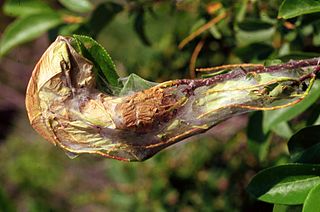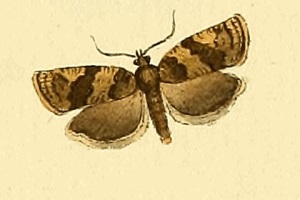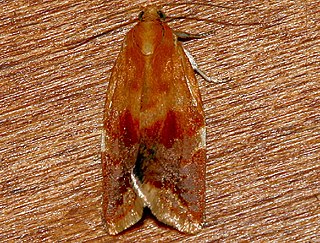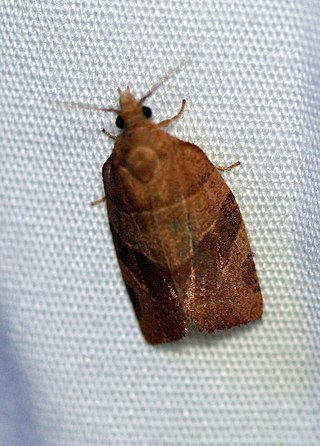
The scalloped oak is a moth of the family Geometridae. The species was first described by Carl Linnaeus in his 1758 10th edition of Systema Naturae.

Pandemis cerasana, the barred fruit-tree tortrix, is a moth of the family Tortricidae.

Choristoneura rosaceana, the oblique banded leaf roller or rosaceous leaf roller, is a moth of the family Tortricidae. It is native to North America, but has been accidentally introduced into other parts of the world.

Archips betulana is a moth of the family Tortricidae. It is found from Fennoscandia south to Italy, Austria and Slovakia and from the Netherlands and Belgium east to southern Russia and the eastern part of the Palearctic realm.

Pandemis corylana, the chequered fruit-tree tortrix, hazel tortrix moth, filbert tortricid or barred fruit tree moth, is a moth of the family Tortricidae. It is found from northern and central Europe to Siberia, Korea and Japan.

Archips argyrospila, the fruit-tree leafroller moth, is a moth of the family Tortricidae. It is found in most of the United States and southern Canada.

Archips cerasivorana, the ugly-nest caterpillar moth, is a species of moth of the family Tortricidae. The caterpillars of this species are known to create nests by tying the leaves of their host plant together. Within the nests, they live and feed off the leaves that have been tied together. The larvae are brownish or greenish yellow with a shiny dark brown head. Larvae can be found from May to July. The species overwinters as an egg, and pupation takes place within the nest. Caterpillars are seen to follow one another in trails, a behavior prompted by the release of signaling pheromones from their spinnerets.
Archips asiaticus, the groundnut leafroller, is a species of moth of the family Tortricidae. It is found in Russia (Siberia), Korea, Japan and China.

Archips capsigeranus is a species of moth of the family Tortricidae. It is found in China, Korea, Japan and Russia.
Archips fuscocupreanus, the exotic leafroller moth or apple tortrix, is a species of moth of the family Tortricidae. It is found in China, South Korea, Japan and Russia. It is an introduced species in the north-eastern United States, where it has been recorded from Connecticut, Massachusetts, New Jersey, New York and Rhode Island. It has also been recorded from Washington.

Archips mortuanus, the dusky-back leaf roller, is a species of moth of the family Tortricidae. It is found in eastern North America, where it has been recorded from Maine, Michigan and New York.
Archips rileyanus, the southern ugly-nest caterpillar moth, is a species of moth of the family Tortricidae. It is found in North America, where it has been recorded from Alabama, Florida, Georgia, Maine, Mississippi, Missouri, North Carolina, Ohio, Tennessee, Texas, Virginia and West Virginia.
Archips semistructus is a species of moth of the family Tortricidae. It is found in China and Japan.
Argyrotaenia loxonephes is a species of moth of the family Tortricidae. It is found in Argentina.

Choristoneura diversana is a species of moth of the family Tortricidae. It is found in Great Britain, France, Belgium, the Netherlands, Germany, Denmark, Austria, Switzerland, Italy, the Czech Republic, Slovakia, Slovenia, Poland, Bulgaria, Hungary, Romania, Norway, Sweden, Finland, the Baltic region, Russia and the Near East. In the east, the range extends to China (Heilongjiang), Korea and Japan. The habitat consists of gardens, scrub and fens.

Clepsis persicana, the white triangle tortrix or the green needleworm, is a species of moth of the family Tortricidae. It is found in North America, where it has been recorded from Alaska and British Columbia to Newfoundland and south to Virginia and west to California. The habitat consists of coniferous and mixed coniferous forests.
Pandemis chlorograpta is a species of moth of the family Tortricidae. It is found in China in the provinces of Heilongjiang, Beijing, Shaanxi, Jiangxi, Sichuan, Fujian and Zhejiang and in Japan.

Pandemis limitata, the three-lined leafroller, is a species of moth of the family Tortricidae. It is found in North America, where it has been recorded from Nova Scotia to British Columbia and from the east coast west to the Rocky Mountains and Arizona. It has also been recorded from Durango in Mexico.
Pandemis pyrusana, the apple pandemis or pandemis leafroller moth, is a species of moth of the family Tortricidae. The species was first described by William D. Kearfott in 1907. It is found in North America, where it has been recorded from Alberta to British Columbia, south through Idaho, Utah and Colorado and California. The habitat consists of forests with deciduous trees and shrubs.

Pandemis lamprosana, the woodgrain leafroller moth, is a species of moth of the family Tortricidae. It is found in North America, where it has been recorded from the north-eastern United States, Quebec and Ontario.













